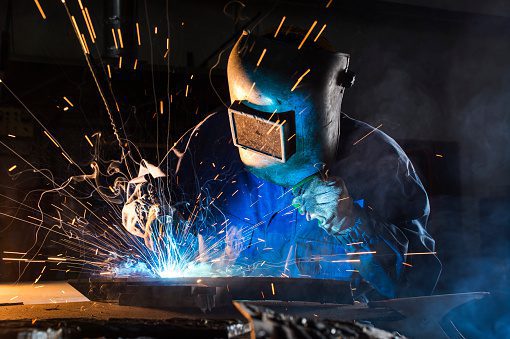| Welder Key Stats | |
|---|---|
| Avg. Salary / year | $55,100 |
| Avg. Pay / hour | $26.49 |
| Education | 0-6 Months |
| Job Outlook | 3% |
| Total Employed | 424,040 |
Metal structures are huge part of modern life and a Welder’s role is essential in creating them.
Welders are responsible for bonding pieces of metal together in order to create all kinds of of structures and buildings.
The welding process involves using extreme heat in order to melt metal parts together and permanently bind them.
Welding professionals will use different techniques and equipment depending on the industry they work in.
Typical industries Welders can be employed in include: Manufacturing, Car racing, Agriculture, Construction Commercial machinery, Industrial machinery, Architecture, Trailer manufacturing, and Automotive manufacturing.
There are almost 100 different types of welding techniques.
The most popular form of welding is called arc welding in which electrical currents are used to produce the necessary heat to melt metals.
The exact type of welding techniques and processes also depend on the type of metal a Welder is fusing together.
For example, steel requires a different welding method than titanium because their melting points differ from one another.
Without experienced and qualified Welders, people wouldn’t be able to utilize several modern technologies including cars, roads, buildings and other structures.
Candidates who want to become a Welder may find that they have the ability to work well with their hands.
If you feel you might be a strong contender for Welding positions, continue reading below to learn about the education requirements, a general job description, salary and wage information and the job outlook for this career.
Go to Page Section:
Education Requirements to Become a Welder
There are several ways candidates can become a Welder.
Qualification requirements depend on the employer; some employers request candidates to have a high school diploma or to have completed a training program.
Some employers may even hire inexperienced Welders and provide on the job training for them.
However, most employers will seek candidates who have had training or years of experience as a Welder.
Students who want to become a Welder have a several options to choose from when deciding on a welding training program.
Vocational schools, community colleges, technical schools and private welding, soldering and brazing schools offer training programs.
Candidates should have a basic understanding of the welding process and having several years of experience will help candidates be competitive.
If in a training program, students will benefit from taking classes such as mechanical drawing, shop mathematics, metallurgy, chemistry, physics, electricity and computer courses.
Candidates who go into a specialized welding profession will require certification in order to qualify for these jobs.
Some employers offer training a certification within their company; however, you can seek your certification from the American Welding Society (AWS).
Visit the AWS website to learn more about the certification they offer as well as their requirements.
Welder Job Description
A Welder may use blueprints and plans in order to determine what welding technique they need to use to join metal together.
Some highly experienced Welders would fuse pieces of metal together that are odd in shape such as a pipe circular in shape.
The types of metal a Welder can fuse together include steel, aluminum or titanium.
All these metals melt at different temperatures.
An experienced Welder would use the appropriate welding techniques to fuse the metal parts together.
Using their welding knowledge, they will set up the correct equipment necessary to perform the job, follow the blueprint or plans created in advance and make sure that all safety requirements are met.
Welder Salary and Career Path
The majority of Welders work in manufacturing industries and the job outlook for this career is expected to undergo little to no change over the next decade.
The Bureau of Labor Statistics reports there will be a 2% to 7% decline for welders due to increased automation productivity.
Candidates who have the most experience will be more sought after due to employers need for highly qualified workers.
The Bureau of Labor Statistics also states that the national median income for all Welders and other related positions is approximately $16.13 per hour; this was the median wage in 2008.The salary range for the same positions are approximately $10.85 to $24.38 per hour.
![]() The below information is based on the 2024 BLS national averages.
The below information is based on the 2024 BLS national averages.
National Average Salary
$55,100Average Salary by State
| State | Avg. Annual Salary |
|---|---|
| Alabama | $49,440 |
| Alaska | $76,370 |
| Arizona | $58,390 |
| Arkansas | $48,970 |
| California | $61,980 |
| Connecticut | $66,330 |
| Delaware | $61,310 |
| District of Columbia | $66,140 |
| Florida | $52,570 |
| Georgia | $49,960 |
| Hawaii | $75,510 |
| Idaho | $51,670 |
| Illinois | $53,630 |
| Indiana | $53,020 |
| Iowa | $52,280 |
| Kansas | $52,360 |
| Kentucky | $51,320 |
| Louisiana | $62,290 |
| Maine | $58,680 |
| Maryland | $59,800 |
| Massachusetts | $64,380 |
| Michigan | $52,780 |
| Minnesota | $59,220 |
| Mississippi | $51,360 |
| Missouri | $53,100 |
| Montana | $56,310 |
| Nebraska | $53,060 |
| Nevada | $62,300 |
| New Hampshire | $60,080 |
| New Jersey | $64,500 |
| New Mexico | $60,390 |
| New York | $60,700 |
| North Carolina | $53,340 |
| North Dakota | $62,700 |
| Ohio | $52,210 |
| Oklahoma | $50,820 |
| Oregon | $59,550 |
| Pennsylvania | $53,210 |
| Rhode Island | $61,480 |
| South Carolina | $50,900 |
| South Dakota | $49,280 |
| Tennessee | $49,420 |
| Texas | $54,380 |
| Utah | $57,200 |
| Vermont | $56,560 |
| Virginia | $58,250 |
| Washington | $64,730 |
| West Virginia | $52,720 |
| Wisconsin | $55,660 |
| Wyoming | $68,540 |
| Guam | $43,080 |
| Puerto Rico | $29,100 |
| Virgin Islands | $58,520 |
The highest-paying state in this field is Alaska, with an average salary of $76,370.
Here are the five states with the highest salaries in the field:
* Employment conditions in your area may vary.
Frequently Asked Questions
What does a welder do?
Welders use special equipment to join metal parts by applying heat.
Welding is used in many different areas, such as automobile manufacturing, construction, shipbuilding, and aerospace applications.
There are many different welding processes but arc welding is the most common.
This procedure uses electrical currents to create heat that bonds metals together.
As a welder, you will read blueprints, inspect the structures and the materials that will be welded, calculate the dimensions of the parts that will be welded, monitor the welding process and maintain equipment.
Welders may have to work indoors or outdoors, sometimes in inclement weather on a platform high off the ground.
They are exposed to a number of work hazards and to protect themselves from being injured welders use safety shoes, protective gloves, masks, and goggles.
As a welder, you will need dexterity, physical stamina, technical skills, and attention to detail.
How much does a welder make?
According to the Bureau of Labor Statistics, the median annual wage for welders, cutters, solderers, and brazers was $41,380 as of May 2018.
Salaries in this field vary based on many factors and, as a welder, you can earn anywhere between less than $30,000 and more than $60,000 a year.
How much does it cost to become a welder?
Welders typically need a high school diploma, technical post-secondary training, and/or on-the-job training.
The exact education requirements depend on the employer; some are willing to hire inexperienced workers and train them on the job while others prefer employees who have completed some technical training.
Welding school can cost you anywhere between $5,000 and more than $15,000, depending on the school, the duration and the complexity of the program.
Some welding positions also require a Certified Welding Inspector or Certified Robotic Arc Welding certification.
What is the demand for welders?
According to the Bureau of Labor Statistics, employment of welders, cutters, solderers, and brazers is projected to grow 3 percent from 2018 to 2028.
The expertise of welders will be needed to rebuild the aging infrastructure and to participate in the construction of new facilities.
Job opportunities will also appear in the manufacturing industry.
Employment prospects depend on the worker’s specialty and skill level and those who are familiar with the latest technologies should have good job prospects.
So, in order to have an advantage over your competitors in the job market, you should keep your training up-to-date.
How long does it take to become a welder?
Exact educational requirements depend on the employer; you may find entry-level employment with just a high school diploma and learn welding on the job but some employers prefer welders who have some technical training in the field.
Welding school can be finished in a few months and includes theoretical and practical training.
Your training should include courses in blueprint reading, shop mathematics, physics, chemistry, metallurgy, but also electricity.
Entry-level workers will also need a few months of on-the-job training.














